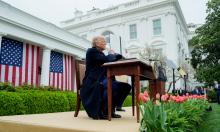Legendary pilot Scott Crossfield killed in small plane crash
Scott Crossfield, the hotshot test pilot and aircraft designer who in 1953 became the first man to fly at twice the speed of sound, was killed in the crash of his small plane, authorities said Thursday. He was 84.

Crossfield's body was found in the wreckage Thursday in the mountains about 50 miles (80 kilometers) northwest of Atlanta, a day after the single-engine plane he was flying dropped off radar screens on a flight from Alabama to Virginia. There were thunderstorms in the area at the time.
The cause of the crash was under investigation. Crossfield was believed to be the only person aboard.
During the 1950s, Crossfield embodied what came to be called "the right stuff," dueling the better-known Chuck Yeager for supremacy among America's Cold War test pilots. Yeager broke the sound barrier in 1947; only weeks after Crossfield reached Mach 2, or twice the speed of sound, Yeager outdid him.
The Cessna 210A in which Crossfield died was a puny flying machine compared with the rocket-powered aircraft he flew as a test pilot. During his heyday, he routinely climbed into some of the most powerful, most dangerous and most complex pieces of machinery of his time, took them to their performance limits or beyond, or "pushed the envelope," as test pilots put it, and brought them back to Earth in one piece.
"He's really one of the major figures," said Peter Jakab, aerospace chairman at the Smithsonian Air and Space Museum. "He was not only the great cutting-edge research pilot ... but after that, he continued to be a great adviser and participant in all aspects of aerospace."
Crossfield, who lived in Herndon, Virginia, and flew regularly into his 80s, was one of a group of civilian pilots assembled by the National Advisory Committee for Aeronautics, the forerunner of NASA, in the early 1950s. Yeager did his test-flying as an Air Force pilot.
Crossfield flew Mach 2 on Nov. 20, 1953, when he hit 1,300 mph (2,092 kph) in NACA's Douglas D-558-II Skyrocket. The plane reached an altitude of 72,000 feet (21,600 meters).
After leaving NACA, he had a major role in the development of the X-15 rocket plane and piloted it on several of its early test flights in the early 1960s.
"We keep talking about test pilots, but there is no such thing as a `test pilot,"' he said in a 1988 interview with Aviation Week & Space Technology. "They are all just people who incidentally do flight tests. ... We should divest ourselves of this idea of special people (being) heroes, if you please, because really they do not exist," reports AP.
O.Ch.
Subscribe to Pravda.Ru Telegram channel, Facebook, RSS!





